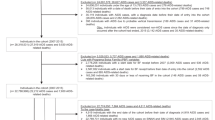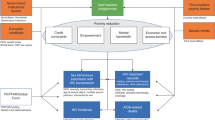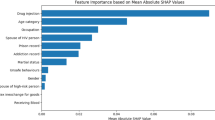Abstract
Multiple socioeconomic vulnerabilities are associated with an increased burden of human immunodeficiency virus and its progression to acquired immunodeficiency syndrome (AIDS). Here, using a quasi-experimental impact evaluation design and a cohort of 12.3 million low-income Brazilian women (daughters and mothers) from 2007 to 2015, we evaluated the impact and intersectional effectiveness of the world’s largest conditional cash transfer, the Programa Bolsa Família (PBF) on AIDS incidence and AIDS-related mortality. Among daughters, PBF was associated with reductions in AIDS incidence (rate ratio (RR) 0.53, 95% confidence interval (CI) 0.42–0.66) and AIDS-related mortality (RR 0.45, 95% CI 0.27–0.74). Among mothers, PBF was associated with reductions in AIDS incidence (RR 0.58, 95% CI 0.55–0.61) and AIDS-related mortality (RR 0.57, 95% CI 0.53–0.63). The effects of PBF were stronger among mothers with 1 vulnerability, and even higher with 2 intersecting vulnerabilities, specifically for AIDS incidence among brown/Black and extremely low income (RR 0.47, 95% CI 0.44–0.49). The greatest effect was observed in extremely low-income, brown/Black mothers with higher education (RR 0.44, 95% CI 0.38–0.53). Conditional cash transfer could substantially contribute towards reducing AIDS-related inequalities and achieving the AIDS-related Sustainable Development Goal.
This is a preview of subscription content, access via your institution
Access options
Access Nature and 54 other Nature Portfolio journals
Get Nature+, our best-value online-access subscription
$32.99 / 30 days
cancel any time
Subscribe to this journal
Receive 12 digital issues and online access to articles
$119.00 per year
only $9.92 per issue
Buy this article
- Purchase on SpringerLink
- Instant access to full article PDF
Prices may be subject to local taxes which are calculated during checkout

Similar content being viewed by others
Data availability
The protocol for the creation of the 100 Million Brazilian Cohort and the cohort profile of the 100 Million Brazilian Cohort is available in the publications referenced in the article, and further material is available at https://cidacs.bahia.fiocruz.br/en/platform/cohort-of-100-millionbrazilians. The linkage protocols are explained in the referenced publications, and the codes are available on GitHub at https://gitHub.com/gcgbarbosa/cidacs-rl. However, the datasets generated and analysed during the current study are not publicly available due to confidentiality and ethical issues. To request access, contact us at https://cidacs.bahia.fiocruz.br/contato/fale-conosco/. The results supporting the findings of this study are available within the main paper and its supplementary materials. Additional supporting information can be found in the Online Appendix.
Code availability
The code is available upon request due to confidentiality and ethical considerations. To request access, contact us at https://cidacs.bahia.fiocruz.br/contato/fale-conosco/.
References
Wambura, M. et al. Cash transfer to adolescent girls and young women to reduce sexual risk behavior (CARE): protocol for a cluster randomized controlled trial. JMIR Res. Protoc. 8, e14696 (2019).
Rasella, D., Aquino, R., Santos, C. A. T., Paes-Sousa, R. & Barreto, M. L. Effect of a conditional cash transfer programme on childhood mortality: a nationwide analysis of Brazilian municipalities. Lancet 382, 57–64 (2013).
Hargreaves, J. R., Davey, C. & White, R. G. Does the ‘inverse equity hypothesis’ explain how both poverty and wealth can be associated with HIV prevalence in sub-Saharan Africa? J. Epidemiol. Commun. Health 67, 526–529 (2013).
Ranganathan, M. & Lagarde, M. Promoting healthy behaviours and improving health outcomes in low and middle income countries: a review of the impact of conditional cash transfer programmes. Prev. Med. 55, S95–S105 (2012).
Global HIV & AIDS Statistics—Fact Sheet (UNAIDS, 2024); https://www.unaids.org/en/resources/fact-sheet
Stoner, M. C. D., Kilburn, K., Godfrey-Faussett, P., Ghys, P. & Pettifor, A. E. Cash transfers for HIV prevention: a systematic review. PLoS Med. 18, e1003866 (2021).
Liu, J. X. et al. Conditional cash transfers to prevent mother-to-child transmission in low facility-delivery settings: evidence from a randomised controlled trial in Nigeria. BMC Pregnancy Childbirth 19, 1–12 (2019).
Handa, S., Halpern, C. T., Pettifor, A. & Thirumurthy, H. The Government of Kenya's cash transfer program reduces the risk of sexual debut among young people age 15–25. PLoS ONE 9, e85473 (2014).
Baird, S. J., Garfein, R. S., McIntosh, C. T. & Özler, B. Effect of a cash transfer programme for schooling on prevalence of HIV and herpes simplex type 2 in Malawi: a cluster randomised trial. Lancet 379, 1320–1329 (2012).
Heise, L., Lutz, B., Ranganathan, M. & Watts, C. Cash transfers for HIV prevention: considering their potential. J. Int. AIDS Soc. 16, 18615 (2013).
Pettifor, A. et al. The effect of a conditional cash transfer on HIV incidence in young women in rural South Africa (HPTN 068): a phase 3, randomised controlled trial. Lancet Glob. Health 4, e978–e988 (2016).
Richterman, A. & Thirumurthy, H. The effects of cash transfer programmes on HIV-related outcomes in 42 countries from 1996 to 2019. Nat. Hum. Behav. https://doi.org/10.1038/s41562-022-01414-7 (2022).
de Walque, D., Fernald, L., Gertler, P. & Hidrobo, M. in Disease Control Priorities, Third Edition (Volume 8): Child and Adolescent Health and Development (eds Bundy, D. A. P. et al.) 325–342 (World Bank Group, 2017); https://doi.org/10.1596/978-1-4648-0423-6_CH23
Fenton, L. Preventing HIV/AIDS through poverty reduction: the only sustainable solution? Lancet 364, 1186–1187 (2004).
Boletim Epidemiológico HIV/Aids 2022 (Secretaria de Vigilância em Saúde, 2022).
Galea, J. T., Baruch, R. & Brown, B. PrEP Ya! Latin America wants PrEP, and Brazil leads the way. Lancet HIV 5, e110–e112 (2018).
Pescarini, J. M. et al. Effect of a conditional cash transfer programme on leprosy treatment adherence and cure in patients from the nationwide 100 Million Brazilian Cohort: a quasi-experimental study. Lancet Infect. Dis. 20, 618–627 (2020).
Jesus, G. S. et al. The effect of primary health care on tuberculosis in a nationwide cohort of 7·3 million Brazilian people: a quasi-experimental study. Lancet Glob. Health 10, e390–e397 (2022).
Bowleg, L. The problem with the phrase women and minorities: intersectionality—an important theoretical framework for public health. Am. J. Public Health 102, 1267–1273 (2012).
Bauer, G. R. Incorporating intersectionality theory into population health research methodology: challenges and the potential to advance health equity. Soc. Sci. Med. 110, 10–17 (2014).
Barreto, M. L. et al. Cohort profile: the 100 Million Brazilian Cohort. Int. J. Epidemiol. 51, 27–38 (2021).
Unified Registry (WWP, 2024); http://wwp.org.br/en/social-policy/unified-registry/
Ministério da Saúde (DATASUS, 2024); https://datasus.saude.gov.br/
Pita, R. et al. On the accuracy and scalability of probabilistic data linkage over the Brazilian 114 Million Cohort. IEEE J. Biomed. Health Inf. 22, 346–353 (2018).
Nery, J. S. et al. Effect of Brazil’s conditional cash transfer programme on tuberculosis incidence. Int. J. Tuberculosis Lung Dis. 21, 790–796 (2017).
De Walque, D. et al. Incentivising safe sex: a randomised trial of conditional cash transfers for HIV and sexually transmitted infection prevention in rural Tanzania. BMJ Open 2, e000747 (2012).
Fahey, C. A. et al. Durability of effects from short-term economic incentives for clinic attendance among HIV positive adults in Tanzania: long-term follow-up of a randomised controlled trial. BMJ Glob. Health 6, e007248 (2021).
de Sampaio Morais, G. A. et al. Effect of a conditional cash transfer programme on AIDS incidence, hospitalisations, and mortality in Brazil: a longitudinal ecological study. Lancet HIV 9, e690–e699 (2022).
Ranganathan, M. et al. Transactional sex among adolescent girls and young women enrolled in a cash plus intervention in rural Tanzania: a mixed‐methods study. J. Int. AIDS Soc. 25, 26038 (2022).
Lua, I. et al. The effects of social determinants of health on acquired immune deficiency syndrome in a low-income population of Brazil: a retrospective cohort study of 28.3 million individuals. Lancet Reg. Health Am. 24, 100554 (2023).
Sunil, T. S. & Xu, X. Substance abuse and HIV/STD prevention at a Hispanic-serving institution in South Texas: a study of racial/ethnic and gender heterogeneity and intersectionality. J. Ethn. Subst. Abuse 20, 257–274 (2021).
Longman Marcellin, R., Bauer, G. R. & Scheim, A. I. Intersecting impacts of transphobia and racism on HIV risk among trans persons of colour in Ontario, Canada. Ethn. Inequal. Health Soc. Care 6, 97–107 (2013).
Miller, S., Johnson, N. & Wherry, L. R. Medicaid and mortality: new evidence from linked survey and administrative data. Q. J. Econ. 136, 1783–1829 (2021).
Sommers, B. D., Maylone, B., Blendon, R. J., John Orav, E. & Epstein, A. M. Three-year impacts of the affordable care act: Improved medical care and health among low-income adults. Health Aff. 36, 1119–1128 (2017).
Hone, T. et al. Primary healthcare expansion and mortality in Brazil’s urban poor: a cohort analysis of 1.2 million adults. PLoS Med. 17, 1–20 (2020).
Pinto, P. F. P. S. et al. The impact of primary health care on AIDS incidence and mortality: a cohort study of 3.4 million Brazilians. PLoS Med. 21, e1004302 (2024).
Jesus, G. S. et al. Effects of conditional cash transfers on tuberculosis incidence and mortality according to race, ethnicity and socioeconomic factors in the 100 Million Brazilian Cohort. Nat. Med. 31, 653–662 (2025).
Silva, A. F. et al. Income determines the impact of cash transfers on HIV/AIDS: cohort study of 22.7 million Brazilians. Nat. Commun. 15, 1307 (2024).
Victora, C. G. et al. The inverse equity hypothesis: analyses of institutional deliveries in 286 national surveys. Am. J. Public Health 108, 464 (2018).
Boletim Bolsa Família e Cadastro Único n°66 (Ministério da Cidadania, 2020).
Sanni Ali, M. et al. Administrative data linkage in Brazil: potentials for health technology assessment. Front. Pharm. 10, 1–20 (2019).
Pinto, C. et al. Probabilistic integration of large Brazilian socioeconomic and clinical databases. In Proc. IEEE Symp. Comput. Based Med Syst. 515–520 (IEEE, 2017).
Barreto, M. et al. Assessing the accuracy of probabilistic record linkage of social and health databases in the 100 Million Brazilian Cohort. Int J. Popul. Data Sci. 1, 276 (2017).
Pita, R. et al. Design and evaluation of probabilistic record linkage methods supporting the Brazilian 100-million cohort initiative. Int J. Popul. Data Sci. 1, 23889 (2017).
Lindert, K., Linder, A., Hobbs, J. & De La Brière, B. The Nuts and Bolts of Brazil’s Bolsa Família Program: Implementing Conditional Cash Transfers in a Decentralized Context (World Bank, 2007).
Chesnaye, N. C. et al. An introduction to inverse probability of treatment weighting in observational research. Clin. Kidney J. https://doi.org/10.1093/ckj/sfab158 (2021).
Austin, P. C. & Stuart, E. A. Moving towards best practice when using inverse probability of treatment weighting (IPTW) using the propensity score to estimate causal treatment effects in observational studies. Stat. Med. 34, 3661–3679 (2015).
Lever, J., Krzywinski, M. & Altman, N. Points of significance: logistic regression. Nat. Methods 13, 541–542 (2016).
Agresti, A. Categorical Data Analysis (John Wiley & Sons, 2018).
Ali, M. S. et al. Propensity score methods in health technology assessment: principles, extended applications, and recent advances. Front. Pharm. 10, 973 (2019).
Lee, B. K., Lessler, J. & Stuart, E. A. Weight trimming and propensity score weighting. PLoS ONE 6, e18174 (2011).
Lawlor, D. A., Tilling, K. & Smith, G. D. Approaches to causal inference triangulation in aetiological epidemiology. Int. J. Epidemiol. https://doi.org/10.1093/ije/dyw314 (2016).
Acknowledgements
This study was supported by the US National Institute of Allergy and Infectious Diseases, National Institutes of Health (grant number 1R01AI152938). We thank the data production team and all Center for Data Integration and Knowledge in Health—FIOCRUZ collaborators for their work on building the 100 Million Brazilian Cohort. We thank our colleagues from the Collective Health Institute (Federal University of Bahia, Salvador, Brazil) for their valuable contributions during the development of the study. We acknowledge the foundational contribution of Silva, A. F. et al. (Nature Communications, 2024) in the development of the data structure and methodological framework that supported this study. D.M.C. and D.R. acknowledge funding from the Medical Research Council (MR/Y004884/1). D.R. acknowledges support from grant CEX2023-0001290-S funded by MCIN/AEI/10.13039/501100011033 and support from Generalitat de Catalunya through the CERCA Program.
Author information
Authors and Affiliations
Contributions
D.R. and A.F.S. developed the study concept. M.Y.I., M.L.B. and A.F.S. collected the data. D.R., A.F.S., I.L., G.S.J., P.F.P.S.G. and D.M.C. designed the study and investigation. A.F.S., D.R. and P.F.P.S.G. did the data analysis and wrote the first draft of the paper. C.A.S.T.S., L.M., L.E.S. and D.M.C. have contributed to the first draft of the paper. All authors contributed to data interpretation and reviewed and edited the paper. D.R., I.D. and J.M. supervised the study process.
Corresponding author
Ethics declarations
Competing interests
The authors declare no competing interests.
Peer review
Peer review information
Nature Human Behaviour thanks the anonymous reviewers for their contribution to the peer review of this work. Peer reviewer reports are available.
Additional information
Publisher’s note Springer Nature remains neutral with regard to jurisdictional claims in published maps and institutional affiliations.
Supplementary information
Supplementary Information
Supplementary discussion, Figs. 1 and 2, and Tables 1–18.
Rights and permissions
Springer Nature or its licensor (e.g. a society or other partner) holds exclusive rights to this article under a publishing agreement with the author(s) or other rightsholder(s); author self-archiving of the accepted manuscript version of this article is solely governed by the terms of such publishing agreement and applicable law.
About this article
Cite this article
Silva, A.F., Lua, I., Jesus, G.S. et al. Intersectional impact of cash transfers on AIDS among 12.3 million Brazilian women. Nat Hum Behav (2025). https://doi.org/10.1038/s41562-025-02278-3
Received:
Accepted:
Published:
DOI: https://doi.org/10.1038/s41562-025-02278-3



